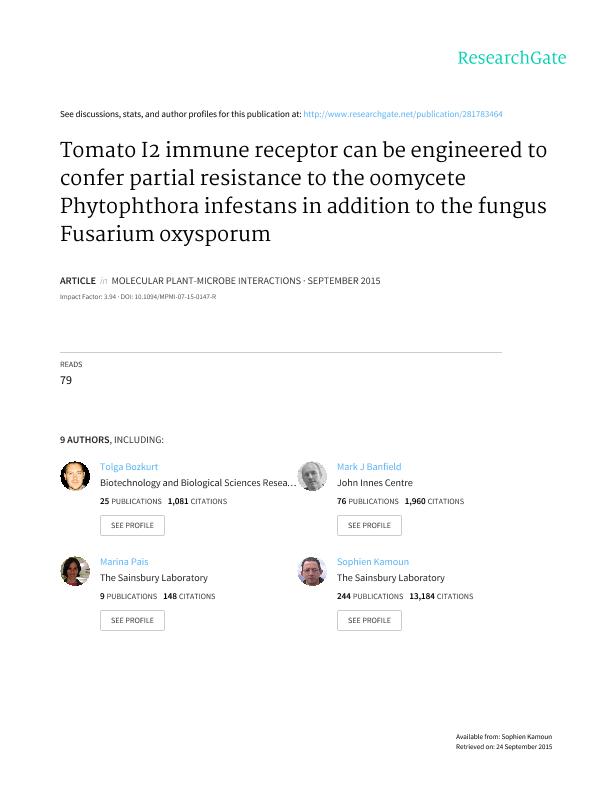Artículo
Tomato I2 immune receptor can be engineered to confer partial resistance to the oomycete Phytophthora infestans in addition to the fungus Fusarium oxysporum
Giannakopoulou, Artemis; Steele, John F. C.; Segretin, Maria Eugenia ; Bozkurt, Tolga; Zhou, Ji; Robatzek, Silke; Banfield, Mark J; Pais, Marina; Kamoun, Sophien
; Bozkurt, Tolga; Zhou, Ji; Robatzek, Silke; Banfield, Mark J; Pais, Marina; Kamoun, Sophien
 ; Bozkurt, Tolga; Zhou, Ji; Robatzek, Silke; Banfield, Mark J; Pais, Marina; Kamoun, Sophien
; Bozkurt, Tolga; Zhou, Ji; Robatzek, Silke; Banfield, Mark J; Pais, Marina; Kamoun, Sophien
Fecha de publicación:
09/2015
Editorial:
American Phytopathological Society
Revista:
Molecular Plant-Microbe Interactions
ISSN:
0894-0282
Idioma:
Inglés
Tipo de recurso:
Artículo publicado
Clasificación temática:
Resumen
Plants and animals rely on immune receptors, known as nucleotide-binding domain and leucine-rich repeat containing proteins (NB-LRR or NLR), to defend against invading pathogens and activate immune responses. How NLR receptors respond to pathogens is inadequately understood. We previously reported single-residue mutations that expand the response of the potato immune receptor R3a to AVR3aEM, a stealthy effector from the late blight oomycete pathogen Phytophthora infestans. I2, another NLR that mediates resistance to the wilt causing fungus Fusarium oxysporum f. sp. lycopersici, is the tomato ortholog of R3a. We transferred previously identified R3a mutations to I2 to assess the degree to which the resulting I2 mutants have an altered response. We discovered that wild-type I2 protein responds weakly to AVR3a. One mutant in the N-terminal coiled-coil domain, I2I141N, appeared sensitized and displayed markedly increased response to AVR3a. Remarkably, I2I141N conferred partial resistance to P. infestans. Further, I2I141N has an expanded response spectrum to F. oxysporum f. sp. lycopersici effectors compared to the wild-type I2 protein. Our results suggest that synthetic immune receptors can be engineered to confer resistance to phylogenetically divergent pathogens and indicate that knowledge gathered for one NLR could be exploited to improve NLRs from other plant species.
Palabras clave:
Nb-Lrr
,
R3a
,
Phytophthora Infestans
,
I2
Archivos asociados
Licencia
Identificadores
Colecciones
Articulos(INGEBI)
Articulos de INST.DE INVEST.EN ING.GENETICA Y BIOL.MOLECULAR "DR. HECTOR N TORRES"
Articulos de INST.DE INVEST.EN ING.GENETICA Y BIOL.MOLECULAR "DR. HECTOR N TORRES"
Citación
Giannakopoulou, Artemis; Steele, John F. C.; Segretin, Maria Eugenia; Bozkurt, Tolga; Zhou, Ji; et al.; Tomato I2 immune receptor can be engineered to confer partial resistance to the oomycete Phytophthora infestans in addition to the fungus Fusarium oxysporum; American Phytopathological Society; Molecular Plant-Microbe Interactions; 28; 12; 9-2015; 1316-1329
Compartir
Altmétricas



